Headed South
Hummingbirds are feasting at feeders and nectar plant sources in preparation of their long-distance flight to wintering grounds.
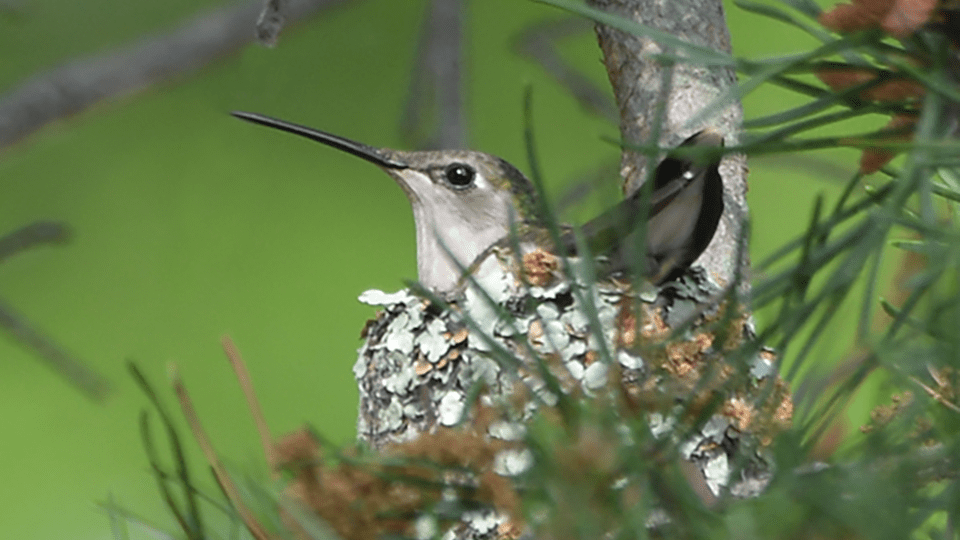
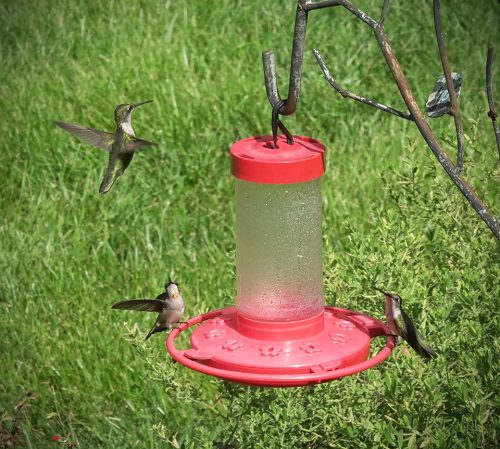
Often, I haven’t hung any hummingbird feeders by late April. A few years ago while washing dishes by the kitchen window an early arrival hummingbird confronted me. He looked at me and then at an empty wrought iron shepherd’s hook about 25 feet away in my garden. I thought, “No way, he surely can’t remember me and where I put the feeder last year?”
Then just in case I didn’t get the message clearly enough he went and hovered at the end of the hook where the feeder “should have been.” He continually turned his head to the empty hook and then to the window. His gorget kept flashing its iridescent neon red at me. He came to the window at least half a dozen times staring me down and then returning his gaze to the hook. Finally he flew to the hook and perched patiently.
Although I couldn’t perceive his 53 to 90 wing beats per second, I was certain I could recognize insistence—and he wanted to be fed now.
“You’re a pushy little devil!” I told him. “Okay, okay.”
I headed to the pantry for sugar and grabbed a pot from the cupboard. I measured the four parts water to one part sugar, boiled it until the crystals were fully dissolved, allowed it cool to room temperature, and then filled a feeder and delivered the goods.
My guest acknowledged the gesture by taking long sips, causing bubbles to percolate up the feeder’s cylindrical shape.
“I don’t recall a proper thank you, but I’m glad to see one of you has made the long journey,” I told him. “In the future I’ll try to be more diligent. Let your friends know we’re open for business!”
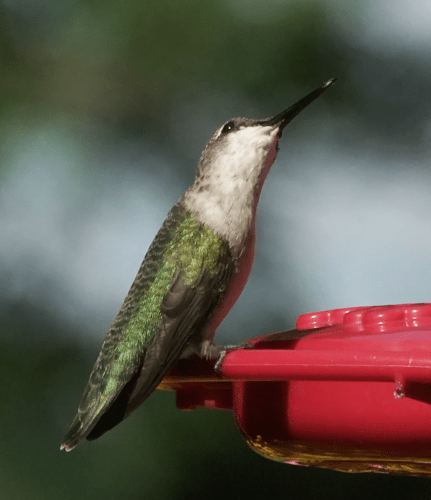
I suspected this was our usual guard bird that chased away other prospective diners and he probably had no invitations in mind.
Lest you think my account is too anthropomorphic, know that studies have proven that hummingbirds (and a number of other bird species) do, in fact, recognize people’s faces. And let me assure you most hummingbirds know their providers by sight. Some folks even feed their rubies while the tiny birds are perched upon a finger.
Here in New Jersey the ruby-throated hummingbird is the only regular member of the species to breed. Seven other types have been spotted in the state but these are vagrants or real rarities. Since fall is approaching and southward migration is upon us, I’ll mention that a number of folks will keep one feeder up for any wayward rufus hummingbird, which is a western species. I’ve only known a few folks to have seen them, but my birding friends are forever hopeful.
This spring we had a slow start to hummingbird season and I was concerned that our little rubies were in short supply. It didn’t seem like the allure of honeysuckle in mid-May could account for their low numbers at the feeders, before the invasive Japanese vine had even burst into bloom.
But by August’s end our females have raised two to three summer broods and the feeders are like little helipads, with tiny missiles zooming about. One feeder has what I believe to be three immature birds feeding at once, sending bubbles up like an ocean’s vent. In general, only one or two birds feed simultaneously, with a constant competition for food. But these three are very tolerant of one another. Nevertheless, intruders keep things stirred up; I’m confident that at least eight birds are using one feeder. Beyond that general impression, my attempts at population calculations falter.
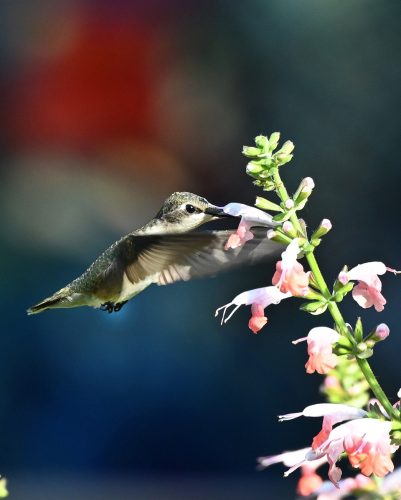
The Georgia Department of Natural Resources suggests one method for calculating how many birds are using your feeder or garden. They recommend quickly tallying the number of birds you see and multiplying by six, which apparently should give you the number of birds you feed in a single day. My feeders are not clustered but spread out, in hopes that guarder birds can’t control the circuit. Additionally, I have lots of flowers providing nectar. In my opinion, although their “cyphering” was presented as science, in the end either they or I seem a bit like Jethro Bodine of The Beverly Hillbillies Clampett family fame—basically baffled.
Although fall migration is upon us, let me discuss their spring reappearance. Since around 2013 HummingbirdCentral.com has been collecting data on hummingbird arrivals from January to May. Rubies winter in Central America, from Mexico to Panama, and along a thin strip around the Gulf Coast and at the tip of Florida. Northernmost migrators are more likely to be those who winter around the Gulf, but some of these Gulf birds are surely year-round residents.
Hummingbird Central receives observers’ sightings of new arrivals and tracks these reports on maps. Their data shows a progression of early arrivals northward beginning in the Gulf of New Mexico states to South Carolina from mid-March to the 28th. By April 2 sightings are confined from the Gulf to the southern side of the Chesapeake Bay. Around April 8 southern New Jersey has its first birds and by the 14th more early arrivals have made it to New England. By late May their mapped birds are fully migrated and lining both sides of the U.S. border with Canada.
Rutgers New Jersey Agricultural Experiment Station suggests New Jersey residents begin to watch for ruby-throated hummingbirds around April 20.
Most of our local birds start their journeys south in August and they are currently feasting intensely on nectar and insects to make their southbound jaunts. Birds who nest north of us also travel through our region and make use of our food resources, and this intensifies the feeder visits.
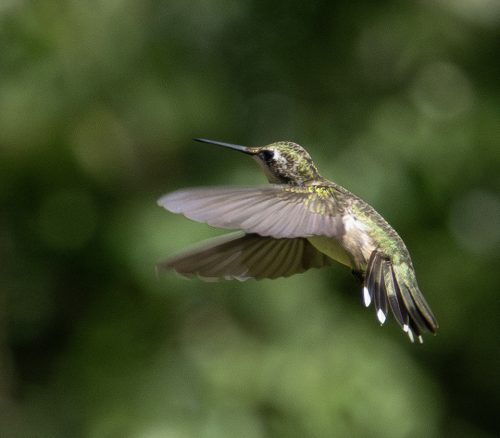
It is commonly thought that the fall migration, or southern return trip, to Central America is triggered by shorter days and declining nectar and insect sources. Even before migration begins, hummingbirds drink 100 percent of their body weight daily and consume up to half of their weight in sugar each day. On average they visit 1,000 to 2,000 blossoms daily. However, hummingbirds and their young need more than sugars/nectar to sustain them; they need proteins as well, which come from insect sources like ants, flies, aphids, and gnats.
Two Canadian research professors discovered that in preparation for and during migration hummingbirds build fat reserves. If body mass/fat ratio falls below 5.0 percent of a hummingbird’s weight they employ a strategy known as torpor, primarily in the evening when not feeding. They lower their body temperature and slow their metabolism up to 95 percent, thus enabling them to increase fat storage up to 20 percent of their body weight. Since ruby-throats weigh less than a nickel, these measurements have to be very precise.
Hummingbirds have a heart rate as high as 1,260 beats per second and a wing beat from 53 up to 200 per second. This burns a lot of calories, so that before migration they need to gain 25 to 40 percent of their body weight to make the trip. Birds use fat as fuel and can’t afford to burn muscle tissue. They are solo migrants, and young ones instinctively know where to go.
Many birds migrate at night but hummingbirds are daytime flyers when nectar sources are more abundant. They also fly low to take advantage of food opportunities. While some species go high to avoid bad weather events, hummingbirds do not employ that strategy. Over land they hunker down to dodge hurricanes and high winds. Ornithologists have studied their progression and know that they make use of tailwinds to boost their efforts.
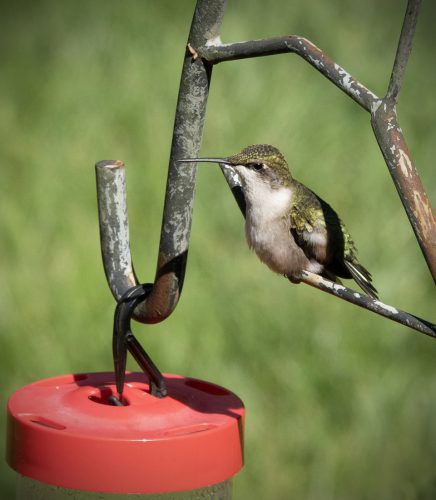
Water crossings are the most perilous for most migrating species. The Gulf of Mexico requires a 22-hour nonstop flight and some individuals choose to skirt the Gulf Coast to avoid that exposure. Unexpected northbound winds present the greatest danger. It is estimated that between 70 and 80 percent of hummingbirds produced in a year will not make it to return in the spring.
Ultimately the habitat that we provide for them when they return will impact their sustainability. So be on the lookout next April for that first little beggar and remember it needs more than sugar water to survive. Offer native plants that provide nectar and also host the native insects that are necessary for the survival of hummingbirds—as well as for all of nature.
Sources
- Reversal of the adipostat control of torpor during migration in hummingbirds, E.R. Eberts, C. Guglielmo, and K. Welch. Dec. 2021, Dept. of Biological Sciences, University of Toronto, Canada, eLife.
- Attracting Ruby-throated Hummingbirds to Your Yard, Kathleen Kerwin, Program Associate, Department of Ecology, Evolution, and Natural Resources Brooke Maslo, Extension Specialist, Wildlife Ecology, Rutgers New Jersey Agricultural Experiment Station, Cooperative Extension Fact Sheet FS1316
- HummingBirdCentral.com
- Ruby-throated Hummingbird, AllAboutBirds.com, Cornell.
- Ruby-throated Hummingbird, US Forest Service Fact Sheet, by Kim Winter, Coevolution Institute









